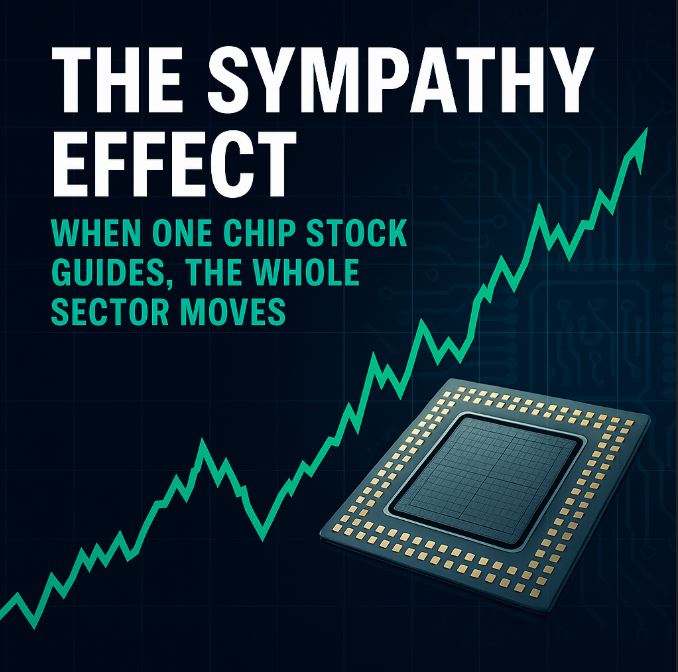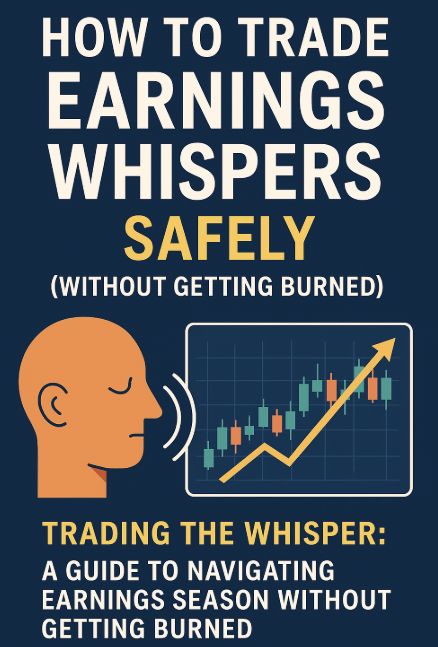
Markets move in packs—and nowhere is this more obvious than in the world of semiconductors. When one chip giant sneezes, the rest of the sector either catches a cold or rallies on its coattails. This “Sympathy Effect” is one of the most powerful, and tradable, dynamics in the market today.
What Is the Sympathy Effect?
The semiconductor sector is deeply interconnected—companies share suppliers, customers, and industry trends. If NVIDIA (NVDA) smashes earnings thanks to AI demand, investors assume AMD (AMD) and TSMC (TSM) will benefit too. The reverse is also true: a cautious outlook from TSMC can drag down NVIDIA, AMD, and the ETFs that hold them.
For traders, these ripple effects create short-term opportunities to ride momentum across multiple names without waiting for individual catalysts.
How to Trade Sympathy Plays
Entry Rules
- Spot the Catalyst: Look for a market-moving event from a leader (earnings beats, product announcements, or guidance shifts).
- Confirm the Lead Stock Move: The first mover (usually NVDA) should show strong pre-market or open-hour momentum.
- Pick the Right Candidate: Direct competitors like AMD move fastest, while suppliers like TSMC also feel the shockwaves.
- Volume Check: Rising volume in the sympathy stock confirms market recognition.
- Technical Trigger: Breakouts, moving-average crossovers, or RSI strength can help time entries.
- Scale In: Consider adding in tranches to avoid overcommitting on a false breakout.
Exit Rules
- Profit Targets: Define your levels upfront—whether percentage gains or Fibonacci extensions.
- Trailing Stops: Lock in profits by following the move with a stop that adjusts upward.
- Watch Momentum: If the lead stock cools off or volume fades, exit quickly.
- Catalyst Invalidation: Exit if contradictory news surfaces (e.g., AMD delays a product while NVDA rallies).
When Sympathy Fails
Not every ripple spreads. Common deal-breakers include:
- Company-Specific Negatives: A product delay or revenue miss in the sympathy stock.
- Conflicting Analyst Calls: Strong “sell” ratings can mute enthusiasm.
- Macro Headwinds: Market-wide selloffs can drown out sector-specific good news.
- Geopolitical Shocks: Tariffs, export bans, or Taiwan tensions often disrupt chip stocks en masse.
- Sector Rotation: If money leaves tech for energy or healthcare, sympathy plays can stall.
Playing It Safer: ETFs
If you’d rather trade the sector than pick winners, semiconductor ETFs like VanEck Semiconductor ETF (SMH) or iShares Semiconductor ETF (SOXX) offer diversified exposure. Big moves from NVDA or AMD often lift these funds, giving you a way to trade the Sympathy Effect without betting on a single name.
Lessons From Past News Cycles
History shows the pattern:
- AI Boom: NVDA earnings consistently pulled AMD higher.
- TSMC Warnings: Pessimistic guidance weighed down the entire sector.
- Tariff Announcements: U.S.–China tech disputes sparked across-the-board selloffs.
Traders who recognize these cycles early position themselves to ride the wave rather than get crushed by it.
Final Takeaway
The Sympathy Effect is a sector-wide momentum strategy hiding in plain sight. Chip stocks don’t move in isolation—NVIDIA, AMD, and TSMC are tied at the hip, and their ETFs amplify the swings. Traders who can quickly identify catalysts, apply disciplined entry and exit rules, and adapt when sympathy breaks down have a powerful edge.
✅ Pro Tip for Market Rumors Daily Readers: Always compare pre-market moves in NVDA with sympathy candidates like AMD and SMH. If the volume and momentum confirm, you’ve found your setup.



